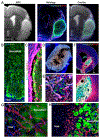A roadmap for promoting endogenous in situ tissue restoration using inductive bioscaffolds after acute brain injury
- PMID: 31128250
- PMCID: PMC6626582
- DOI: 10.1016/j.brainresbull.2019.05.013
A roadmap for promoting endogenous in situ tissue restoration using inductive bioscaffolds after acute brain injury
Abstract
The regeneration of brain tissue remains one of the greatest unsolved challenges in medicine and by many is considered unfeasible. Indeed, the adult mammalian brain does not regenerate tissue, but there is ongoing endogenous neurogenesis, which is upregulated after injury and contributes to tissue repair. This endogenous repair response is a conditio sine que non for tissue regeneration. However, scarring around the lesion core and cavitation provide unfavorable conditions for tissue regeneration in the brain. Based on the success of using extracellular matrix (ECM)-based bioscaffolds in peripheral soft tissue regeneration, it is plausible that the provision of an inductive ECM-based hydrogel inside the volumetric tissue loss can attract neural cells and create a de novo viable tissue. Following perturbation theory of these successes in peripheral tissues, we here propose 9 perturbation parts (i.e. requirements) that can be solved independently to create an integrated series to build a functional and integrated de novo neural tissue. Necessities for tissue formation, anatomical and functional connectivity are further discussed to provide a new substrate to support the improvement of behavioral impairments after acute brain injury. We also consider potential parallel developments of this tissue engineering effort that can support therapeutic benefits in the absence of de novo tissue formation (e.g. structural support to veterate brain tissue). It is envisaged that eventually top-down inductive "natural" bioscaffolds composed of decellularized tissues (i.e. ECM) will be replaced by bottom-up synthetic designer hydrogels that will provide very defined structural and signaling properties, potentially even opening up opportunities we currently do not envisage using natural materials.
Keywords: Biodegradation; Bioscaffold; Brain; Hydrogel; Magnetic resonance imaging; Regeneration; Stroke; Tissue repair.
Copyright © 2019 Elsevier Inc. All rights reserved.
Figures




Similar articles
-
Bioscaffold-Induced Brain Tissue Regeneration.Front Neurosci. 2019 Nov 7;13:1156. doi: 10.3389/fnins.2019.01156. eCollection 2019. Front Neurosci. 2019. PMID: 31787865 Free PMC article. Review.
-
Biodegradation of ECM hydrogel promotes endogenous brain tissue restoration in a rat model of stroke.Acta Biomater. 2018 Oct 15;80:66-84. doi: 10.1016/j.actbio.2018.09.020. Epub 2018 Sep 16. Acta Biomater. 2018. PMID: 30232030 Free PMC article.
-
Post-Stroke Timing of ECM Hydrogel Implantation Affects Biodegradation and Tissue Restoration.Int J Mol Sci. 2021 Oct 21;22(21):11372. doi: 10.3390/ijms222111372. Int J Mol Sci. 2021. PMID: 34768800 Free PMC article.
-
Hydrogel derived from porcine decellularized nerve tissue as a promising biomaterial for repairing peripheral nerve defects.Acta Biomater. 2018 Jun;73:326-338. doi: 10.1016/j.actbio.2018.04.001. Epub 2018 Apr 9. Acta Biomater. 2018. PMID: 29649641
-
Whole Cardiac Tissue Bioscaffolds.Adv Exp Med Biol. 2018;1098:85-114. doi: 10.1007/978-3-319-97421-7_5. Adv Exp Med Biol. 2018. PMID: 30238367 Review.
Cited by
-
In vitro dose-dependent effects of matrix metalloproteinases on ECM hydrogel biodegradation.Acta Biomater. 2024 Jan 15;174:104-115. doi: 10.1016/j.actbio.2023.12.003. Epub 2023 Dec 10. Acta Biomater. 2024. PMID: 38081445 Free PMC article.
-
Injectable biomaterial shuttles for cell therapy in stroke.Brain Res Bull. 2021 Nov;176:25-42. doi: 10.1016/j.brainresbull.2021.08.002. Epub 2021 Aug 12. Brain Res Bull. 2021. PMID: 34391821 Free PMC article. Review.
-
Hepatic Extracellular Matrix and Its Role in the Regulation of Liver Phenotype.Semin Liver Dis. 2024 Aug;44(3):343-355. doi: 10.1055/a-2404-7973. Epub 2024 Aug 27. Semin Liver Dis. 2024. PMID: 39191427 Free PMC article. Review.
-
Engineered glycomaterial implants orchestrate large-scale functional repair of brain tissue chronically after severe traumatic brain injury.Sci Adv. 2021 Mar 5;7(10):eabe0207. doi: 10.1126/sciadv.abe0207. Print 2021 Mar. Sci Adv. 2021. PMID: 33674306 Free PMC article.
-
Bioscaffold-Induced Brain Tissue Regeneration.Front Neurosci. 2019 Nov 7;13:1156. doi: 10.3389/fnins.2019.01156. eCollection 2019. Front Neurosci. 2019. PMID: 31787865 Free PMC article. Review.
References
-
- Anderson MA, O’Shea TM, Burda JE, Ao Y, Barlatey SL, Bernstein AM, Kim JH, James ND, Rogers A, Kato B, Wollenberg AL, Kawaguchi R, Coppola G, Wang C, Deming TJ, He Z, Courtine G, Sofroniew MV, Required growth facilitators propel axon regeneration across complete spinal cord injury, Nature, 561 (2018) 396–400. - PMC - PubMed
Publication types
MeSH terms
Substances
Grants and funding
LinkOut - more resources
Full Text Sources

